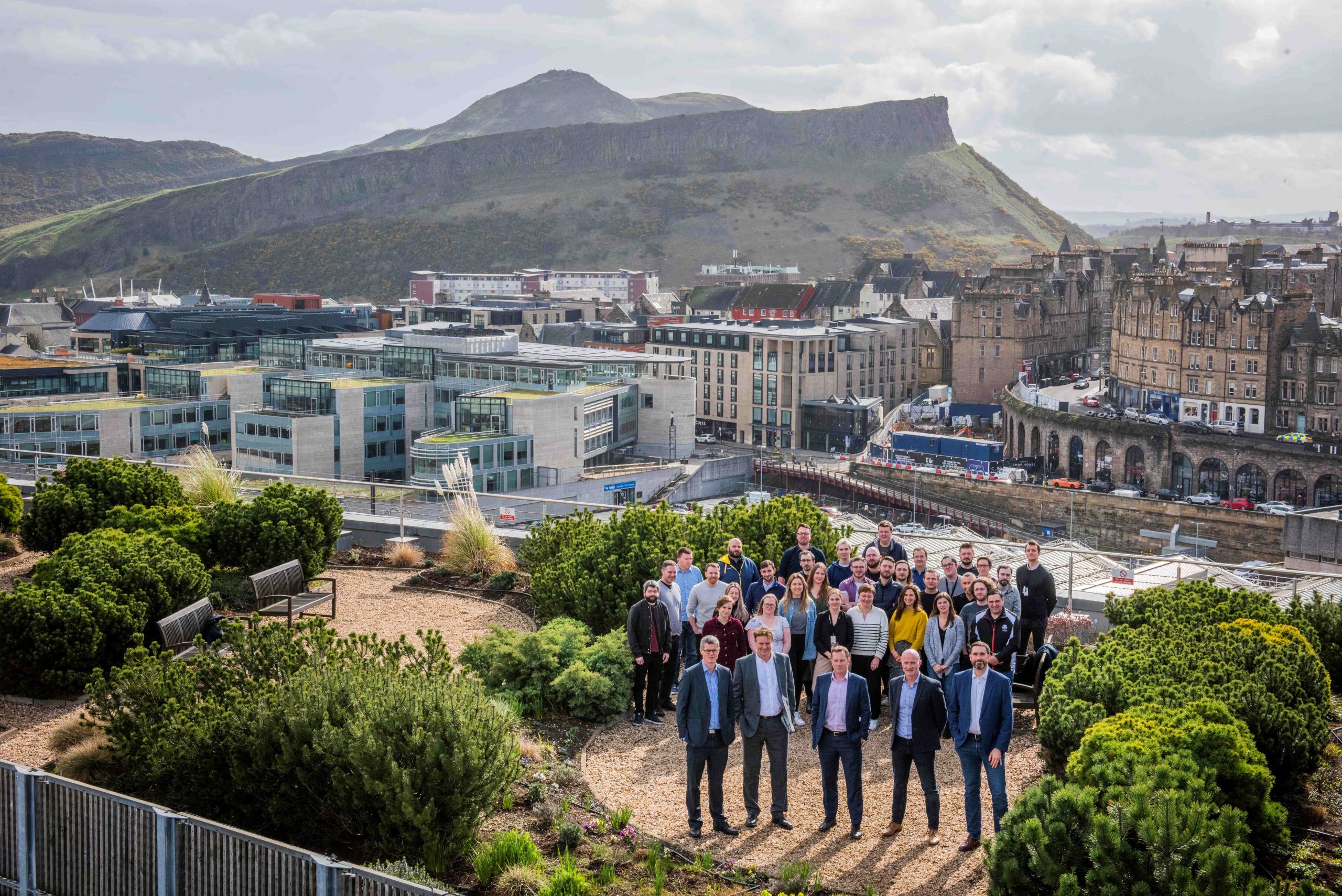Data Centre Business News and Industry Trends
Data Centre Operations: Optimising Infrastructure for Performance and Reliability
Insights into Data Centre Investment & Market Growth
News in Cloud Computing & Data Storage
Sky’s the limit for cloud tech developer
Forrit will expand its operation after receiving scale up support from the Scottish National Investment Bank.
The £5 million of funding will allow the Edinburgh-headquartered technology developer to expand its workforce and target new markets.
The bank’s backing will see the creation of 15 new skilled jobs that will support Forrit’s expansion. The company will also strengthen its relationship with Microsoft as a ‘Preferred Solution’ and Microsoft Partner.
Forrit CEO, Peter Proud, says, “We’ve experienced enormous growth as a company since we launched almost a decade ago - building a brilliant team who have in turn created an extremely strong product. While to date we have self-funded our growth through client engagements, as we take Forrit to the next level, now felt like the right time for us to seek external institutional funding. This investment from the Scottish National Investment Bank will help us to expand our presence, not only in Scotland, but also to expand into new markets across the UK and beyond.
“We are incredibly proud of our Scottish roots, so working with another Scottish organisation was extremely important as both parties are focused on benefitting Scotland. We have ambitious plans and only want to add to the success of the Scottish tech ecosystem. We hope to continue to add to this both as a provider of an exemplary content management system, but also as an employer. Thanks to the bank’s investment, we look forward to growing that even further as we scale up both the company and our product.”
The Forrit investment will help further develop the Scottish tech ecosystem and enhance the sector’s global reputation.
Jimmy Williamson, Executive Director of innovation at the Scottish National Investment Bank says, “The bank’s investment will support Forrit as they look to reach the next stage of their development. Our investment will enable Forrit to create new, high value technology development jobs, futureproofing skills in Scotland’s tech ecosystem and supporting plans to export their differentiated proposition to enterprise clients globally.
“Forrit’s CMS system technology has a strong alignment with our Innovation mission and we look forward to working with them to deliver their ambitious growth plans.”
Beatrice - 13 April 2023
Data Centre Regulations & UK Compliance Updates
Data Centres
Hyperscale Data Centres: Scale, Speed & Strategy
Are nuclear powered data centres on the horizon?
By Ed Ansett, Founder and Chairman, i3 Solutions Group
Small Modular Reactor maker seeks large data centre partner?
Across the globe, activity in the Small Modular Reactor (SMR) space is gathering pace. Governments, regulators, atomic agencies and authorities, global power manufacturers, research bodies and new market entrants are busy. For the data centre industry, the question is whether SMRs are applicable to the sector, could they change how data centres are powered?
A look at the output ranges and the different models under development, and the different nuclear technologies being proposed as suitable for the sector will tell us more.
The first thing to consider about an SMR is its power output. The International Atomic Energy Agency (IAEA) defines 'small' as under 300MWe, and up to about 700MWe as 'medium.'
So, a large data centre deployment is at the small end of the SMR market.
There are also developments in the micro modular reactor category. However, most of the recent activity in terms of regulations, licenses and investments has been in the SMR category.
SMRs under development and being built tell a story
Rolls Royce says its SMR will generate 470MWe. A single Rolls-Royce SMR power station will occupy a space the size of two football pitches and power approximately one million homes, supporting on-grid electricity and a range of off-grid clean energy solutions.
In January 2023, GE Hitachi announced a contract for its BWRX-300 - a 300MWe water-cooled SMR. According to the company, this is the first commercial contract for a grid-scale SMR in north America.
A Danish outfit called Seaborg is planning floating SMRs using barges that can accommodate four 200MWe reactors. It plans to use existing shipyards in which to create a production line for the barges.
In the UK, the Office of Nuclear Regulation is assessing submissions from several firms for the licensing of their technologies. These include US-based Holtec, which submitted its 160MWe pressurised water reactor SMR-160 design developed in collaboration with Mitsubishi Electric of Japan and Hyundai Engineering and Construction of South Korea.
X-Energy, a nuclear reactor and fuel design engineering company, wants to deploy its high-temperature gas reactor in the UK, saying it wants to tackle industrial decarbonisation as well as electricity generation. 'The Xe-100 can deliver reliable ‘always-on’ electricity,' it says, 'as well as increase or decrease power levels safely within minutes to respond to varying demand or supply.'
UK Atomics is a subsidiary of Danish start-up Copenhagen Atomics, which is developing a containerised thorium molten salt reactor. It says its technology is 'progressing swiftly with the first non-radioactive full-size reactor prototype to be tested in the UK in 2023.' The company expects deployment by 2028.
For future large data centre developments, anyone seeking a clean, reliable, low-carbon producing power generation supply, these systems could be applicable.
Current options to fuel SMRs
The World Nuclear Association (WNA) says there are four main SMR technology options being pursued; 'light water reactors, fast neutron reactors, graphite-moderated high-temperature reactors and various kinds of molten salt reactors (MSRs).'
WNA says that, ‘Light Water Reactors are moderated and cooled by ordinary water and have the lowest technological risk, being similar to most operating power and naval reactors today.’’
Fast neutron reactors (FNR) are smaller and simpler than light water types, they have better fuel performance and can have a longer refuelling interval (up to 20 years), but a new safety case needs to be made for them.'
'High-temperature gas-cooled reactors use graphite as a moderator (unless fast neutron type) and either helium, carbon dioxide or nitrogen as primary coolant.'
'Molten salt reactors mostly use molten fluoride salts as primary coolant, at low pressure. Lithium-beryllium fluoride and lithium fluoride salts remain liquid without pressurization up to 1400°C, in marked contrast to a PWR which operates at about 315°C under 150 atmospheres pressure. Fast-spectrum MSRs use chloride salt coolant. In most designs, the fuel is dissolved in the primary coolant, but in some, the fuel is a pebble bed.'
WNA also states many small reactors are being designed for industrial heat applications as well as power generation.
Light water reactors are constrained by pressure limitations and operate in the 300-400°C range. Liquid metal fast reactors are in the 400-600°C range, molten salt reactors are around 600-700°C, and high-temperature reactors are 600-900°C.
Possible use cases for SMRs
2022 and 2023 saw a number of large data centre development projects in the 200MWe range, many of them in South East Asia.
Last year, Yondr Group said it would develop a 200MWe hyperscale campus in Malaysia. The company announced a plan to develop 72.8 acres of land in Johor’s Sedenak Tech Park.
T5 Data Centres announced the planned development of a 140-acre, 200MWe government and enterprise cloud data centre campus in Augusta, Georgia, which it described as the South East US cyber security hub.
In South Korea, energy and construction firm Bosung Group said it is to build a 200Mwe data centre campus in SolaSeaDo, in Jeonnam Province. The company has partnered with The Green Korea (TGK), a joint venture between South Korean energy investment firm Energy Innovation Partners (EIP) and Diode Ventures.
None of these developments has made any announcement on the potential use of nuclear power as a primary power source. Today, the timeframes for SMR production and licensing stretch to 2028 and beyond, so it could be that none of the currently publicised projects can wait that long.
However, things could change quickly.
Beatrice - 23 March 2023
Hyperscale Data Centres: Scale, Speed & Strategy
Insights into Data Centre Investment & Market Growth
News
AirTrunk links its $5bn financing platforms to ESG
AirTrunk has linked 100% of its debt funding platforms to sustainability commitments following the raising of a $650 million Sustainability Linked Loan (SLL) in Japan. Across its financing platforms, AirTrunk has raised $5 billion in Environmental, Social and Governance (ESG) financing, making the company one of the largest issuers of sustainable financing in the data centre industry globally.
The incremental Japan SLL will finance a major expansion of AirTrunk TOK1 (TOK1) and is the first SLL for a data centre in Japan, and the first in APJ to combine operating energy and water efficiency as Key Performance Indicators (KPIs).
Energy and water are critical and interdependent resources that impact a data centre’s environmental footprint. As part of its commitment to accountability and transparency, AirTrunk continues to focus its financing KPIs on actual energy usage through operating power usage effectiveness (PUE) as opposed to design PUE.
AirTrunk plans to invest any margin incentives from the Japan SLL into social impact initiatives within Japan. Plans are underway to expand the program across APJ to support long term initiatives aligned to AirTrunk’s purpose of scaling and sustaining the region’s digital future. This will include supporting initiatives across four focus areas: equal digital access, STEM education, biodiversity and conservation, and innovation and research and development.
AirTrunk Chief Financial Officer, Prashant Murthy says, “By driving innovation in sustainable financing and creating a lasting impact in our communities, we are committed to powering positive industry change. We have now linked all our debt platforms to sustainability commitments, more than doubling our sustainable financing since our inaugural SLL launched in 2021. Our sustainable finance platform complements our recent commitment to net zero emissions by 2030.”
Beatrice - 14 March 2023
Data
Data Centre Regulations & UK Compliance Updates
Data Centre Security: Protecting Infrastructure from Physical and Cyber Threats
Is your business compliant with data sovereignty requirements?
By Florian Malecki, Executive Vice President Marketing, Arcserve
Data sovereignty regulations, like the Data Governance Act in Europe, can be challenging for companies. One of the main difficulties is keeping track of where data is stored, and ensuring that the storage adheres to local data-privacy regulations.
Data sovereignty refers to the jurisdiction and control of data and how it is stored, used, and protected. It is a significant concern for businesses, as data is increasingly a main driver of decision-making and business growth. However, the growing digitisation of operations and the proliferation of cloud computing have created new challenges for businesses.
Data sovereignty means that data handling must follow the rules of the country where the data is collected. So, suppose a business based in the US collects customer data from France. In that case, it must comply with the European Union’s GDPR and any other local laws in handling the data. These regulations can create problems for businesses that operate globally, as they may have to maintain multiple data centres in different countries to comply with the laws and regulations of those countries. It can be costly and logistically complicated, and it may also create vulnerabilities in data security.
It also means that the country or jurisdiction where a business is based may not necessarily have sovereignty over all the data it holds.
Companies also need to know and prove who has access to their data. For instance, many organisations are now putting their most sensitive information in the cloud, including trade secrets and valuable customer data. If hackers get access to this kind of information, it can risk the company's future. By keeping track of who is accessing their data, companies have a better shot at preventing unauthorised users from getting in.
Data sovereignty has implications for data backup
The consequences can be severe when companies run afoul of data sovereignty regulations. One consequence of not complying is the risk of fines and legal penalties. Many countries have strict laws to protect their citizens’ data, and businesses that fail to comply with these laws may be subject to hefty fines and stiff legal penalties.
Businesses that don’t comply with data sovereignty regulations may also face other challenges, such as being unable to recover their data or access their backups in the event of a cyber breach or natural disaster. This situation can have severe consequences for the company, as it may be unable to operate effectively without this data.
To avoid problems, choose the right cloud provider
Companies can ensure they meet data sovereignty regulations by selecting a cloud service provider that complies with all relevant laws and regulations. Many cloud service providers offer data centres in different locations worldwide and can help companies ensure that their data is stored and processed in compliance with local laws.
Along these lines, the European Commission has advocated for the inclusion of sovereignty provisions for cloud service providers. These sovereignty requirements are intended to put EU data out of the reach of foreign jurisdictions. Companies must do their due diligence and choose a reputable cloud service provider with a solid track record of staying on the right side of regulations.
Another way that companies can ensure compliance is by implementing strong data governance policies and procedures themselves. This includes establishing clear rules and guidelines for collecting, storing, and using data and implementing robust security measures to protect against data breaches and unauthorised access. Companies should also consider implementing data masking or encryption techniques to protect sensitive data and ensure compliance with data sovereignty regulations.
Additionally, with data becoming an increasingly valuable asset, companies must start thinking about more than just compliance - they must consider how they can protect their data as laws evolve and new regulations emerge. This means adopting processes and tools that go beyond the bare-minimum requirements and truly prioritising data protection.
Companies can also ensure compliance with data sovereignty regulations by being transparent and open about their data practices. These practices include being upfront about where data is stored and how it is used and being responsive to any requests or inquiries from customers and clients regarding their personal data. By being transparent and open about their data practices, companies can build trust with their customers and demonstrate their commitment to compliance with data sovereignty regulations.
Make 3-2-1-1 a top priority
Finally, a solid data backup and recovery strategy is essential for any business because it helps to protect against data loss and ensures that critical information is available when needed. Specifically, a 3-2-1-1 data-protection strategy can help companies comply with data sovereignty requirements by providing multiple copies of essential data stored in different locations.
The strategy involves keeping three copies of data, with two stored on-premises in different physical locations and two copies stored offsite, such as in the cloud. The final one in this strategy stands for immutable object storage. It involves continuously taking snapshots of your data every 90 seconds, ensuring that you can quickly recover the data even in the event of data loss due to natural disasters, cyber attacks, or other incidents.
As nations race to establish sovereign data regulations and policies, the issue of data security and ownership is rapidly moving to the forefront. It is becoming increasingly important for organisations to understand where their data is stored and who holds the keys to that data, particularly cloud computing. The ongoing digital transformation amplifies the importance of these issues. Organisations must prioritise data security to safeguard their reputation and brand and bolster customer trust.
Beatrice - 3 March 2023
Data Centre Build News & Insights
Data Centre Compliance: Standards, Risk & Governance
Data Centre Projects: Infrastructure Builds, Innovations & Updates
Data Centres
Secure I.T. Environments builds 1MW energy efficient data centre
Secure I.T. Environments has announced the handover of a 1MW, 200 cabinet, data centre design and build project for Proximity Data Centres.
Designed, built and project managed by Secure I.T. Environments, the new facility was built into the ground floor of an existing building containing data centres, and is 441m2 in size. The perimeter of the data centre was based on a 60 minute fire-rated modular wall and roof construction, which included a separate UPS and switch room located in another area.
The mechanical and electrical (M&E) specification was designed to comfortably handle a constant 1MW load, based on 200-cabinets at 5kW per cabinet. The modular design of the M&E infrastructure means that components can be added to support the needed load in incremental phases to match the IT load.
Energy efficient N+1 air conditioning, was supplied and installed throughout the installation, as well as Novec fire suppression and VESDA detection, extraction systems, environmental controls and security systems, including CCTV, door access systems, intruder alarms and leak detection.
The project included the management of planning permission applications for all plant equipment on site, and ensuring compliance with development, health and safety, and building control regulations at every stage for both construction and fire safety compliance. A full-time project team was allocated to the project, conducting regular inspections to ensure contract specifications and quality were maintained.
John Hall, Managing Director, Colocation at Proximity Data Centres, says, “This was a significant expansion of the data centre services we offer at a key site, and we wanted to ensure the best possible outcomes. The data centre has been designed to achieve the best possible annualised PUE and Secure I.T. Environments has done an excellent job of delivering the project, handling every aspect of construction, installation and testing.”
Chris Wellfair, Projects Director at Secure I.T. Environments, adds, “It is always great to work with clients that are truly committed to having the most energy efficient data centres. Having complete ownership of a data centre project means we can ensure the most efficient build programme, and for our clients means they have only one place to go to get things done and discuss progress. It is great to be handing over this data centre to Proximity on time, in budget, and to a world class specification.”
Beatrice - 2 March 2023
Data Centre Infrastructure News & Trends
Data Centres
Insights into Data Centre Investment & Market Growth
MDC boosts technology capabilities with significant investment
MDC Data Centres is pleased to announce a $3.4 million investment in upgrading its data centre infrastructure. During the past year, the company has purchased state-of-the-art equipment from Bud Griffin & Associates to upgrade its MCA2 data centre.
This investment will enable MDC to offer improved quality of service to its clients, as well as stay up to date on the latest technologies and best practices in the industry. The partnership with BGA will provide MDC Data Centres with access to its expertise and resources, further enhancing the company's commitment to providing top-notch data centre services to its customers.
"At MDC, our clients' satisfaction and long-term relationships are our top priorities. We believe that investing in our infrastructure with top providers such as BGA is an investment for the success of our clients. This upgrade to our MCA2 data centre will provide improved quality of service to our customers and minimise the risk of downtime, ensuring that we continue to be a trusted partner for businesses," says Ivan Eng, Strategic Planning Director at MDC.
BGA recognises that in today's world there are no ‘typical’ network applications. Every company's network is critical. BGA not only has the solutions, but also the knowledge and experience to support these application needs. Whether it is a large data centre or a remote site that requires single phase power and monitoring, BGA offers the technology and support to surpass its customers' needs.
Beatrice - 2 March 2023
Data Centres
Hyperscale Data Centres: Scale, Speed & Strategy
Insights into Data Centre Investment & Market Growth
Increasing data centre power consumption in an energy crisis
Paul Brickman, Commercial Director, for Crestchic Loadbanks, explores the often-overlooked necessity of loadbank testing in securing data centre power in an energy crisis.
Hiked power prices as a result of Russia’s fuel sanctions, and the threat of planned blackouts or power rationing to better manage an unstable grid, are forcing data centres to redistribute investment away from key business functions like training and recruitment, and towards improving energy efficiency and securing power resilience.
The current geopolitical challenges and their far-reaching implications are recognised in the 2023 Uptime Institute report, Five Data Centre Predictions for 2023, in which the authors acknowledge that the Russian fuel sanctions, along with technological challenges 'will make the planning of data centre development and operations more difficult.'
Powering next-generation data centres
According to the Uptime Institute, IT hardware has been fairly standard in terms of its draw on mainstream server capacity for a few decades now, creating technical stability and relatively constant power and cooling requirement.
This has enabled data centre designers to accommodate several IT refreshes without major upgrades to server technology and the associated hike in power consumption that would come with it. Essentially, offering the latest technologies, without an increase in energy requirement.
This grace period is now over. Power requirements for next-generation IT hardware are far higher, rack power density is increasing, and 'hotter' processors are putting pressure on the performance parameters of existing infrastructure.
This rapid rise in IT power density means server power consumption is on a steep climb, creating a need for more power, at a time when the grid is unstable, and energy prices are at their highest in decades.
Extreme-density racks are now commonplace in technical computing too, as well as high-performance analytics and artificial intelligence training. If data centre operators want to successfully penetrate these niche markets, they will need to foot the heightened energy bill and maintain a robust power resilience regime until the situation stabilises.
Data centres take action
The demand for next-generation IT technologies will not slow. As a result, data centres are forging ahead with the essential upgrades required to UPS, batteries, switchgear and generators to accommodate increased power density.
This is a risk. With an unstable grid and planned blackouts still on the agenda for many governments, upgrades will need to be bolstered with a watertight energy resilience plan to protect against power fluctuations and total outages.
The importance of a power resilience strategy in an energy crisis
According to research from the Ponemon Institute, in its third Cost of Data Centre Outages report, the total cost of downtime has continued to rise over the last six years - rising a staggering 38% to $740,357 per incident. That equates to nearly $9,000 per minute - a figure that many data centres will have to swallow if the grid becomes too unstable to sustain their increasing power consumption.
Many data centres will already have a robust generator testing and maintenance regime in place, but the use of loadbanks is often overlooked, especially when budgets are stretched. At a time when power outages are more likely, loadbank testing should play an integral role in a data centre’s energy resilience strategy and it would be prudent to evaluate your strategy in line with the current landscape to ensure it is robust enough. With this in mind, what would be considered best practice for testing a backup power system?
Best practice loadbank testing in times of crisis
Ideally, as a minimum, all generators should be tested annually for real-world emergency conditions by using a resistive-reactive 0.8pf loadbank. Best practice dictates that all gensets (where there are multiple) should be run in a synchronised state, ideally for eight hours but for a minimum of three.
Where a resistive-only loadbank is used, testing should be increased to two to four times per year at three hours per test. In carrying out this testing and maintenance, fuel, exhaust and cooling systems are effectively tested and system issues can be uncovered in a safe, controlled manner without the cost of major failure or unplanned downtime. The alternator is not thoroughly tested though, with a resistive-only test and therefore a resistive-reactive test would always be recommended.
It may be advisable to test more frequently during times of crisis for added peace of mind.
Why is resistive-reactive the best approach?
Capable of testing both resistive and reactive loads, this type of loadbank provides a much clearer picture of how well an entire system will withstand changes in load patterns while experiencing the level of power that would typically be encountered under real operational conditions.
Furthermore, the inductive loads used in resistive/reactive testing will show how a system will cope with a voltage drop in its regulator. This is particularly important in any application which requires generators to be operated in parallel (prevalent in larger business infrastructures such as hyperscale data centres) where a problem with one generator could prevent other system generators from working properly or even failing to operate entirely. This is something which is simply not achievable with resistive-only testing.
Navigating growth when power is scarce
No matter the geopolitical challenges and the effect it is having on power availability, data centres have no choice but to grow.
Demand will not cease, and power-intensive next-generation technologies are unavoidable. Ensuring power resilience via a watertight backup power supply and a robust testing and maintenance regime will enable data centre designers and operators to grow, safe in the knowledge that, should planned blackouts, power rationing or grid fluctuations happen, the power will always remain on.
Beatrice - 24 February 2023
Insights into Data Centre Investment & Market Growth
News
Infinidat names Steve Sullivan as Chief Revenue Officer
Infinidat has announced the promotion of Steve Sullivan to Chief Revenue Officer (CRO). Steve previously held the position of Executive Vice President and General Manager, Americas, where he demonstrated his leadership skills and sales acumen.
As Chief Revenue Officer, Steve will be responsible for overseeing all revenue-generating activities within Infinidat, including sales, go-to-market strategy, and customer success on a global scale. He will provide dynamic leadership for high-performance teams that are data-driven, insights-oriented, and proactive with customers and channel partners. The alignment of revenue functions under one senior executive will support the company’s growth initiatives.
“We are pleased to promote a proven, highly successful, and trusted executive leader to a position crucial to Infinidat’s continued growth and success,” says Phil Bullinger, CEO at Infinidat. “Steve brings to the CRO role a track record of building and leading high-performing teams that have set a very high standard for customer success and delivering technical and business value in enterprise storage. His leadership in the expanded CRO role will accelerate our growth as we scale our global account and partner relationships through collaborative and cohesive go-to-market strategies and programs.”
“I am honored to be promoted to Chief Revenue Officer and look forward to continuing to work with our talented teams across the globe to drive revenue growth and expand our market share,” says Steve. “We have such a highly differentiated value proposition for our customers, and we continually rank highest in customer success, two key components for continued growth. We will always continue to extend our investments in the total customer experience, ranging from solution architecting in collaboration with our channel partners to our white glove service and support that has earned the loyalty of global enterprises around the world.”
Steve brings over 25 years of executive sales experience in the storage industry to the role. Prior to joining Infinidat, Steve held senior leadership positions in various companies, where he developed a strong track record of revenue growth and customer acquisition. He has a B.S. in Finance from Boston College and an MBA from the Babson F.W. Olin Graduate School of Business.
Beatrice - 24 February 2023
Data Centres
Insights into Data Centre Investment & Market Growth
Vertiv introduces new prefabricated modular data centre solution
Vertiv has introduced the Vertiv MegaMod and Vertiv MegaMod Plus, a turnkey prefabricated modular (PFM) data centre solution, deployable in expandable units of 0.5 or 1MW for IT loads up to 2MW or more. The prefabricated modules are integrated and tested with Vertiv power management systems, thermal management solutions, remote monitoring and IT equipment racks to deliver performance, and help companies reduce deployment time by up to 40% when compared to a traditional data centre build.
Companies are racing to deploy processing power in new locations to meet demand for digital business products and services. The MegaMod, and the MegaMod Plus - which offers up to 25% more rack and cooling capacity - enable customers to expand core-to-edge data centre networks and rapidly deploy new compute capacity with lower upfront costs, greater predictability and less risk than traditional data centre builds, thanks to proven industrial processes and high standards of quality control. Both solutions provide options to grow horizontally or vertically, with MegaMod providing cooling capacity in the IT Hall area, while MegaMod Plus is configured with cooling modules that support the IT hall space expansions.
“Historically, facilities have typically been stick-built, requiring long lead times and heavy upfront capital investment. However, growing digitalisation trends have urged investors and data centre operators to reconsider this approach,” says Viktor Petik, Vice President and EMEA leader for Vertiv’s Integrated Modular Solutions business. “As demand for digital services soars, data centre owners are better able to capture this growth if they can accelerate the rollout of new capacity. The good news is that prefabricated modular data centres like Vertiv MegaMod enable stakeholders to act quickly.”
Vertiv says that the solution is ideal for medium size data centres, and can be easily deployed and expanded as business needs grow. Vertiv also provides end-to-end services for a straightforward start-up and smooth operation, including deployment, commissioning, ongoing maintenance, remote monitoring and training.
Beatrice - 7 February 2023
Commercial Real Estate: Property Developments, Trends & Infrastructure
Data Centres
Hyperscale Data Centres: Scale, Speed & Strategy
Insights into Data Centre Investment & Market Growth
News
DCI Data Centres appoints group CEO
DCI Data Centres (DCI) has announced the appointment of Nicholas Toh as the group Chief Executive Officer.
Nicholas is an industry veteran with more than 20 years’ experience across data centres, finance and real estate investments. He joins DCI from STT Global Data Centres, where he was one of the key founding team members, having been instrumental in the growth and development of the business, most recently as CEO, North-East Asia. During his time with STT GDC, he led market entry into the mature markets of UK and Japan as well as strategic investments and partnerships into India, South Korea, Indonesia, and the Philippines. Prior to joining STT, he was Senior Vice President at Securus Data Property Fund. An Australian national, Nicholas has also worked for Macquarie Group within the Banking and Financial Services group, as well as within Macquarie’s Real Estate group.
DCI Chair and Brookfield Global CEO Data Centres, Udhay Mathialagan says Nicholas brings an impressive track record in building data centre businesses across multiple geographies, marking a strategic milestone as DCI enters an accelerated growth phase.
“Nicholas’s appointment strengthens DCI’s growth trajectory as we look to build on our rapid growth in Australia and New Zealand by deepening our geographic and product strength in these markets in addition to targeted expansion across Asia. I am delighted to welcome Nicholas to the team,” adds Udhay.
“DCI’s growth and commitment to scale makes it an exciting time to join the company. DCI’s customer centric approach and ability to provide innovative solutions has enabled them to be a trusted partner, and I look forward to continuing to build the business and usher in new successes for our hyperscale customers,” Nicholas says.
Beatrice - 6 February 2023

Head office & Accounts:
Suite 14, 6-8 Revenge Road, Lordswood
Kent ME5 8UD
T: +44 (0)1634 673163
F: +44 (0)1634 673173









